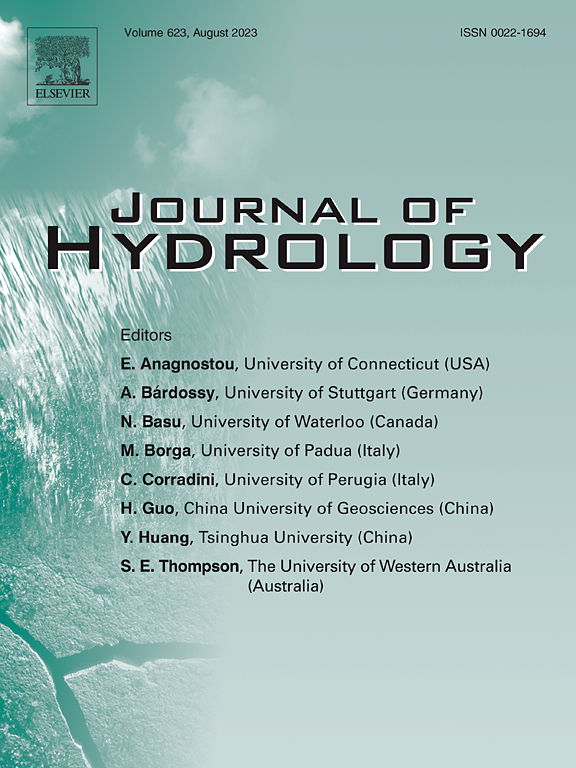Analysis of the impact of confining layers on aquifer thermal energy storage (ATES) systems with a horizontal well doublet
IF 6.3
1区 地球科学
Q1 ENGINEERING, CIVIL
引用次数: 0
Abstract
Aquifer thermal energy storage (ATES) utilizes groundwater aquifers to store excess heat and conserve energy. The system is gaining popularity due to its potential in the energy transition as a renewable energy source. To better design the ATES system, it is critical to understand and model the heat transport process in the domain. Current studies applying numerical and analytical solutions to simulate ATES systems often simplify the model by ignoring the confining layers. Additionally, some studies fail to consider both transverse and longitudinal heat conductivity in this mode. This study presents a novel approach to modeling the ATES system by incorporating upper and lower confining layers with different geological materials. The thermal anisotropy of confining materials is incorporated into the model to evaluate the influence of transverse and longitudinal heat transport processes on thermal energy loss in the aquifer. More importantly, the model is tested with horizontal well doublets, which have not been discussed before. The results indicate that the horizontal well is as compatible as conventional vertical wells under the parameters used in this study. Ignoring confining layers, however, will overestimate the system’s recovery efficiency. With relatively large injection and extraction rates, the anisotropy of the confining materials has a minimal impact on the system. Overall, considering the existence of confining layers is critical for accurate ATES system modeling, and more accurate analytical or numerical models are still needed to better constrain the relative importance of each thermal parameter.
水平井双井围水层对含水层储热系统的影响分析
蓄水层热能储存(ATES)利用地下水蓄水层来储存多余的热量和保存能量。该系统由于其作为可再生能源在能源转型中的潜力而越来越受欢迎。为了更好地设计ATES系统,理解和模拟区域内的热传递过程是至关重要的。目前应用数值和解析解来模拟ATES系统的研究往往通过忽略约束层来简化模型。此外,一些研究没有同时考虑这种模式下的横向和纵向导热性。本研究提出了一种新的方法,通过结合不同地质物质的上下围合层来模拟ATES系统。将围合材料的热各向异性纳入模型,评价了横向和纵向热输运过程对含水层热能损失的影响。更重要的是,该模型用水平井双井进行了测试,这是以前没有讨论过的。结果表明,在本研究所采用的参数下,水平井与常规直井具有相同的相容性。然而,忽略限制层将高估系统的恢复效率。当注入和萃取速率相对较大时,围封材料的各向异性对体系的影响最小。综上所述,考虑约束层的存在对于精确的ATES系统建模至关重要,仍然需要更精确的解析或数值模型来更好地约束每个热参数的相对重要性。
本文章由计算机程序翻译,如有差异,请以英文原文为准。
求助全文
约1分钟内获得全文
求助全文
来源期刊

Journal of Hydrology
地学-地球科学综合
CiteScore
11.00
自引率
12.50%
发文量
1309
审稿时长
7.5 months
期刊介绍:
The Journal of Hydrology publishes original research papers and comprehensive reviews in all the subfields of the hydrological sciences including water based management and policy issues that impact on economics and society. These comprise, but are not limited to the physical, chemical, biogeochemical, stochastic and systems aspects of surface and groundwater hydrology, hydrometeorology and hydrogeology. Relevant topics incorporating the insights and methodologies of disciplines such as climatology, water resource systems, hydraulics, agrohydrology, geomorphology, soil science, instrumentation and remote sensing, civil and environmental engineering are included. Social science perspectives on hydrological problems such as resource and ecological economics, environmental sociology, psychology and behavioural science, management and policy analysis are also invited. Multi-and interdisciplinary analyses of hydrological problems are within scope. The science published in the Journal of Hydrology is relevant to catchment scales rather than exclusively to a local scale or site.
 求助内容:
求助内容: 应助结果提醒方式:
应助结果提醒方式:


